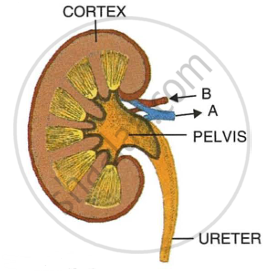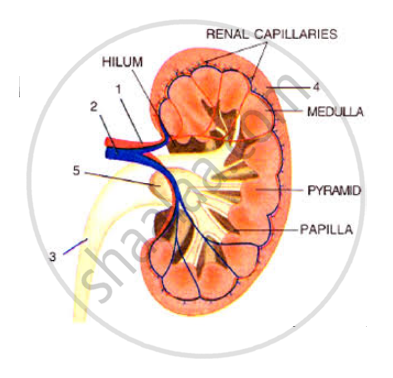Advertisements
Advertisements
Question
Describe the mechanism of urine formation in human excretory system. Draw a labelled diagram to illustrate your answer.
Solution
Kidneys are the main excretory organ of the human body. There are about millions of nephron in each kidney. Each nephron contains a renal corpuscle and a renal tubule. The renal corpuscle consists of capillaries called the glomerulus, enclosed by a capsule called Bowman's capsule. The blood containing wastes (like urea) enters the glomerulus. The glomerulus filters the blood. During filtration, the filtrate (containing substances like glucose, amino acids, salts, water and urea) present in the blood travels through the renal tubule where materials needed by the body are reabsorbed, while the wastes like urea are collected and excreted in the urine. The nephron carries the urine into the collecting tubule of the kidney from where it is carried to the ureter. From the ureter, the urine passes into the urinary bladder. The urinary bladder stores the urine until it is forced out of the body, through an opening known as the urethra.

APPEARS IN
RELATED QUESTIONS
the Biological/technical term Pigment providing colour to urine.
The given diagram represents a nephron and its blood supply. Study the diagram and answer the following questions:

(i) Label parts 1, 2, 3 and 4.
(ii) State the reason for the high hydrostatic pressure in the glomerulus.
(iii) Name the blood vessel which contains the least amount of urea in this diagram.
(iv) Name the two main stages of urine formation.
(v) Name the part of the nephron which lies in the renal medulla.
Differentiate between the following pair on the basis of what is indicated in the bracket.
Ureter and Urethra [function]
Name an animal which absorbs oxygen through its moist skin.
What gaseous waste products are excreted by plants?
What job is done by the kidneys?
A dialysis machine contains long tubes coiled in a tank containing dialysing solution
What does the dialysing solution contain?
What are the methods used by plants to get rid of their waste products?
The organs A of a person have been damaged completely due to which too much of a poisonous waste material B has started accumulating in his blood, making it dirty. In order to save this person's life, the blood from an artery in the person's arm is made to flow into long tubes made of substance E which are kept in coiled form in a tank containing solution F. This solution contains three materials G, H and I in similar proportions to those in normal blood. As the person's blood passes through long tubes of substance E, most of the wastes present in it go into solution. The clean blood is then put back into a vein in the arm of the person for circulation.
(a) What are organs A?
(b) Name the waste substance B.
(c) What are (i) E, and (ii) F?
(d) Name G, H and I.
(e) What is the process described above known as?
Tick the most appropriate answer.
The process of removing waste from the body is called
Answer the following in short.
List five waste products of plants.
Look at the figure given bellow, it is a section of human kidney as seen from the front.

Is it a longitudinal section or a cross-section?
Given below is a simplified diagram of the human kidney cut open longitudinally. Answer the questions that follow.
 |
- Define excretion.
- Why does the cortex of the kidney show a dotted appearance?
- Why does the medulla of the kidney show a striped appearance?
- Write two differences in the composition of the blood flowing through the blood vessels 'A' and 'B'.
Choose the odd one out in the following series:
Proximal convoluted duct, loop of Henle, vein.
Choose the odd one out in the following serie:
Column of Bertini, minora calyces, brain.
Look at the figure given below. It is a section of human kidney as seen from the front.

Which area/part (give its name and number given on the diagram) which contains the following:
(i) Malpighian capsule
(ii) The pyramids
(iii) Freshly collected urine
Name the Following
The structural and functional units of kidney
The habitat of animals that excrete nitrogenous waste in the form of urea.
Choose the odd one out in the following set and write the category for the remaining terms:
